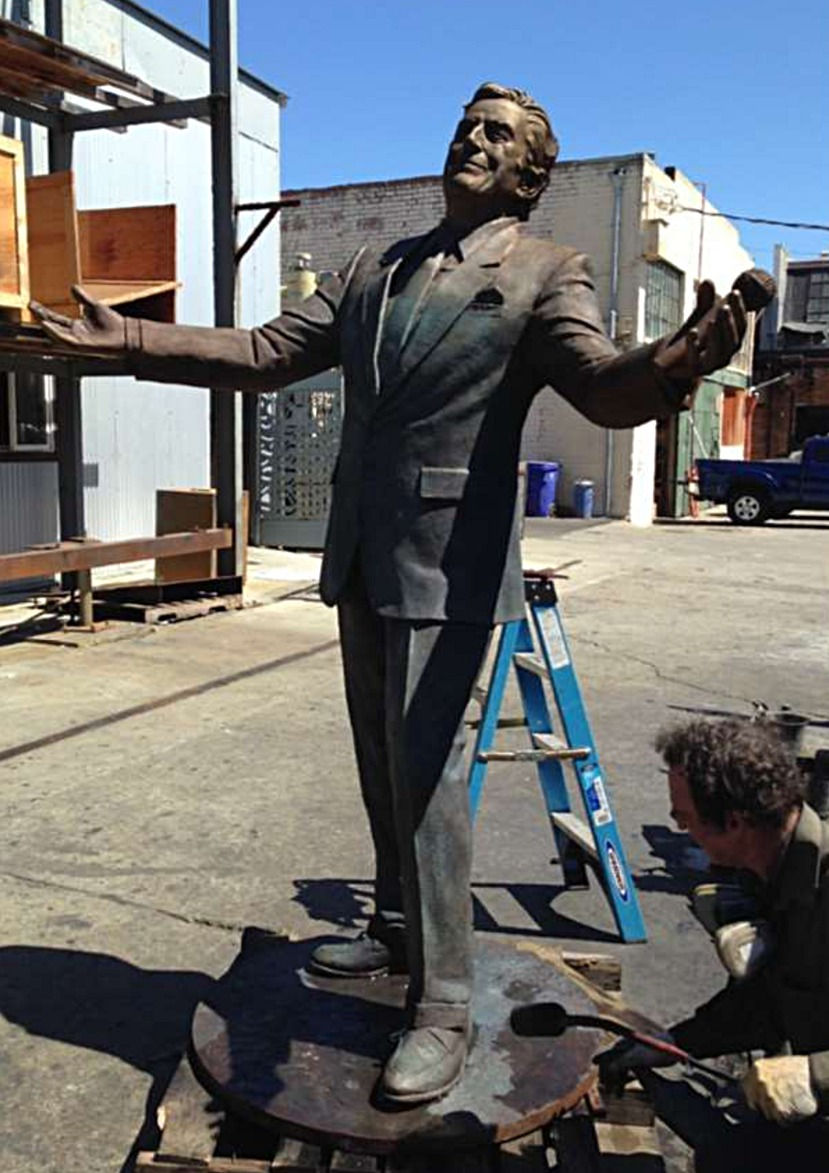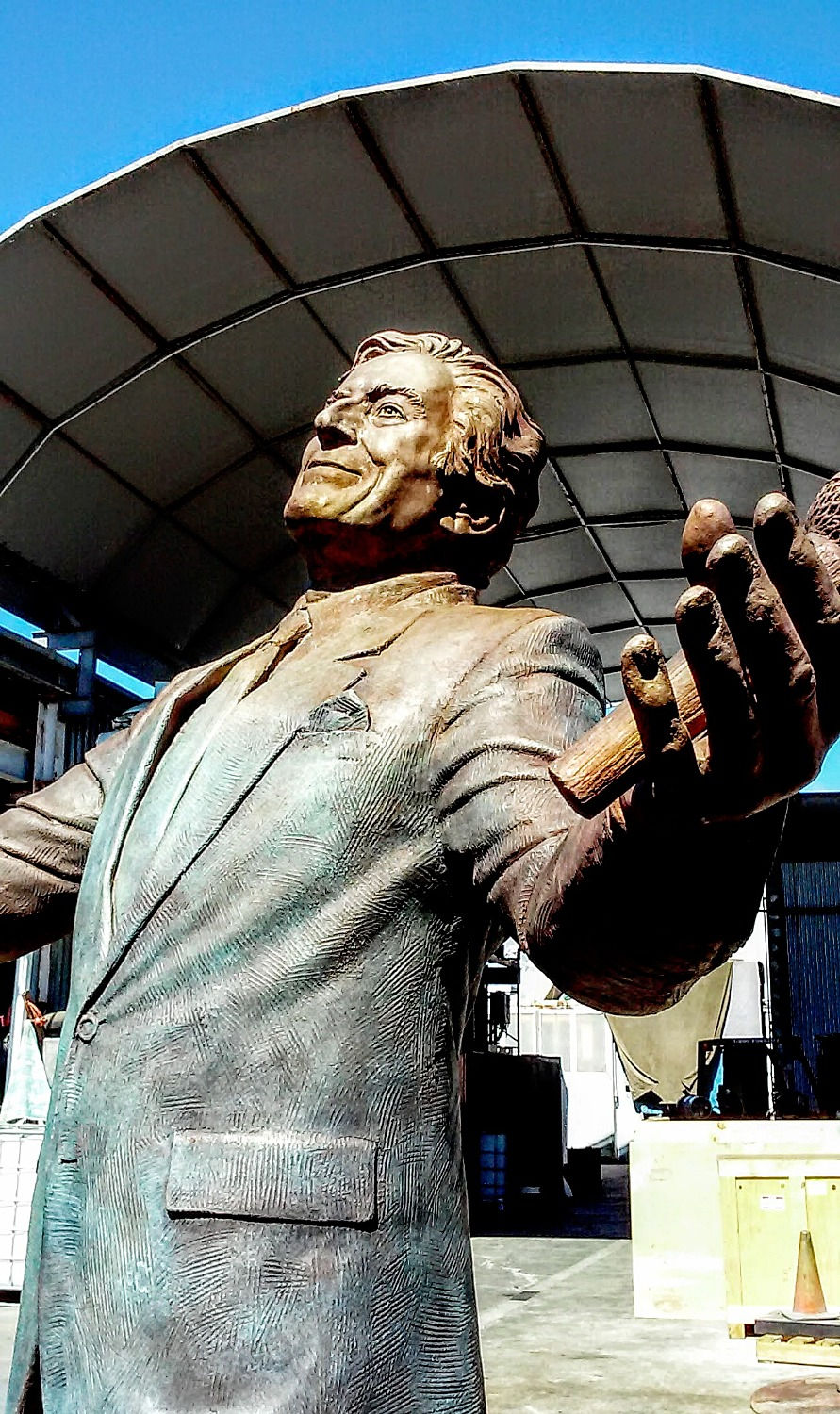

Gavin Newsom Returns to SF City Hall,
This Time as a Bronze Bust
June 27, 2018.
The Governor Gavin Newsom bust was unveiled at San Francisco’s City Hall. Sculptor Bruce Wolfe’s work captures Newsome’s signature look of combed back hair and open-collared button down shirt. The bust was positioned in the 2nd floor gallery, just outside the doors of the office of the Mayor, joining Diane Feinstein, Willie Brown and George Moscone.


SF Takes Tony Bennett to Heart by Unveiling Statue.
Classic Crooner Tony Bennett, accompanied by S.F. Protocol Chief Charlotte Shultz, celebrates the unveiling of an 8-foot-tall bronze statue in his honor Friday in front of the Fairmont Hotel on Nob Hill. The singer, who turned 90 on Aug. 3, will forever be known for “I Left My Heart in San Francisco.”

















"One of the final and most important steps in the foundry process is the application of the patina. A good patina can make all the difference giving the final statue the final color that will define the permanent perception of the work. Karl Reichley is a masterful artist in his own right, providing just the right combination of chemicals on the Bennett statue to give it a distinct San Francisco feel. A darker color with hues of copper green, make the statue feel as if its been exposed to the sea air for decades and give it a common lineage to all the great statues throughout the City."
Bruce Wolfe, Sculptor of Tony Bennett Statue

USC's Tommy Trojan, Meet Your Female Counterpart: Hecuba, Queen of Troy
ince the 1930s, the life-size bronze warrior Tommy Trojan has been the unofficial mascot of USC and a central campus gathering spot. Now he has a female counterpart at USC Village — the $700-million complex of residential colleges, shops and restaurants just north of the main campus. The new development is the university’s largest construction project, and USC President C.L. Max Nikias from the start saw a sculpture as its centerpiece. Tommy Trojan, modeled after USC football players, flexes every muscle in his body at once. Nikias wanted the new statue to do something perhaps equally impossible: embody the breadth of campus diversity.That’s what he told local sculptor Christopher Slatoff, whose work includes the new “Enduring Heroes” memorial to soldiers in Pasadena.
A devotee of classical antiquity, Nikias told Slatoff he was drawn to Hecuba, a queen of Troy in Greek mythology.
Hecuba, he said, was a model of resilience. She urged the Trojans to fight on “even when they were outnumbered, exhausted, facing impossible odds.”
Hecuba will be publicly unveiled Thursday.
S
August 17, 2017.
Patina specialist Karl Reichley works on the Hecuba statue for the USC Village at Artworks Foundry in Berkeley. (Gus Ruelas / USC)
To achieve the desired texture and tones for the patina, he heated the bronze with a torch and sprayed on chemicals to change the surface composition. He scrubbed it with Cupric Nitrate for greenish tones and with Ferric for a brownish red. In places, he polished to let the raw bronze show through to add an authentic integrity to the sculpture.













Bringing Hecuba Home
On a Friday night in July, a fully assembled Hecuba was strapped onto a flatbed truck and driven 390 miles south. USC Village project director William Marsh, with the help of a structural engineer and a dozen others, figured out how to cradle the 3,600 pound sculpture onto large furniture dollies, push her across the plaza and slowly rock her upright with a forklift. They built scaffolding and a chain-rig system to hoist her up in the morning, when the president would decide exactly how she should be positioned.
It had been more than seven years since USC had first announced its project plans, three years since the groundbreaking. The campus had overcome early opposition from neighborhood activists — agreeing, among other things, to pay $20 million to support affordable housing in the area and $20 million for street upgrades. Now, the fountain was up and running, the 180 trees were planted, the residential halls were furnished, ready to house 2,500 students.
When Nikias arrived to see Hecuba — framed by a California coastal live oak, lined up with the new clock tower — he admired her greenish tint and the way it harmonized with the new buildings’ brick facades. Hecuba looks so majestic, so regal — she’s beautiful, he told Slatoff. He circled the sculpture, craning his neck, studying the patterns, the braids, the sunlight on the ribbon’s curves. He examined the three quotes etched onto the statue and checked that the English translations from Euripides’ “Hecuba” matched the ones he had chosen and handwritten in ancient Greek:
“Those who have power ought not exercise it wrongfully, nor when they
are fortunate should they imagine that they will be so forever.”


